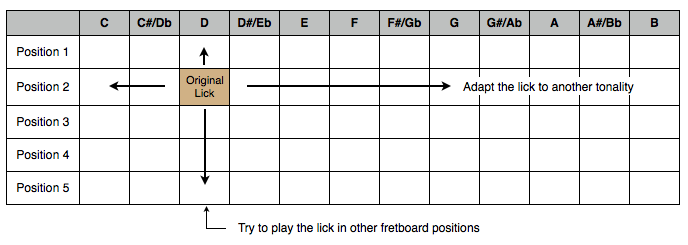
12 - Create your own licks
Licks are short melodies and phrases, which have a length of about two or four bars. They sound cool and are fun to play.You will find some licks here in this Tips & Tricks compilation, and in method books or videos on YouTube as well. Advanced musicians have also the possibility to sound out, what the masters are playing and to copy their best licks.
Recycle your favourite licks
Learn a new lick always with the awareness, what notes are played and over what chords you could play it.This gives you the oportunity, to play it in any key and any other song. I call that "recycling". You will be surprised, how few licks you need, to "cheat" through a Jazz standard. Of course, this method will not be the final solution, but we have to start somewhere and use what we already have and can.
Licks can not only be transposed, they can be played in different positions on the neck as well.
Here an overview, how many options you have, to adapt a lick (5 x 12 = 60).

Transposing a melody to another key will probably be easy. An adaption to another position can be quite a challenge, but also a creative way and maybe you'll find some even better sounding melody lines. Like this, you can give your licks a personal touch.
You should practice a lick for several days with 2 goals in mind...
- try to raise the speed over the time.
- try to integrate your lick in a solo on the fly. Find out, where good places are. Nail it!
2-5-1 chord progrogressions
You'll find a 2-5-1 progression in almost every Jazz standard.It's a good idea, to learn some 2-5-1 licks.
Here a list of songs with 2-5-1 progressions in major...
- "Djangology", the last four bars- "Dinah", the last four bars
- "Hungaria", the last four bars
- "It don't mean a thing", at the beginning of the B-part
- "Blue Bossa", bars 9-12
The 2-5-1 progression is also used in a minor context.
Rhythm Changes
Melodies over Rhythm Changes (1-6-2-5) are easy to transpose too. Their licks work great in any other key.For example: A cool lick over "Swing 42" (C major) can be played two frets higher and will fit perfectly over the rhythm change "Daphne" (D major).
Djangolizer Power-User:
When you practiced a wicked lick from a book or a video, you can check out on Djangolizers fretboard view, how it works over the chord/s (cognitive learning).You can see, if the lick is made of arpeggio notes or scale notes.
Are there some chromatic notes inserted?
With what note does the lick start?
On what note does the lick end?
On the third? Fifth? Seventh? Sixth? Rootnote? Change to the interval view, to check that.
After such an analysis, you can adapt any lick to your needs.
You got a lick, that fits over a minor chord?
Why not changing it to a major or a dominant lick?
Just check on Djangolizers fretboard, where the 3rd and the 7th of that chord is. Then adjust those notes in your lick, but keep the rhythmic elements.
The constructive jam session
Invent your own licks! Here some suggestions, how Djangolizer could help you to get creative.The following tips base upon the two chords E7 and Am, which are played in "Minor Swing".
For this examples, you should set the Djangolizer fretboard view to position 3.
This chord progression is a simple V7 - Im connection, how you'll find it in all Jazz songs in minor.
Later, you can adapt these tips to other chord progressions like V7 - I in major for example.
10 tips for your creativity
1 - Play arpeggio notes over the E7 chord and land at count 1 of the Am chord on one of the three A's. Do not land on any other note than A yet.2 - You can vary your solo, by starting from another E note. You got two of them.
3 - Don't play the first note on the beat, but on the off beat. Did you feel, how the mood and groove changed completely?
4 - Rotate. First, start the arpeggio on the on beat (1 or 2) and the next time on an off beat (1+ or 4+).
5 - Play the arpeggios in eights with a swing feel. Then play it in triplets. Play eights up and triplets down.
6 - Turn on the scale view. For E7, set the scale to Phrygian Dominant and for Am the Harmonic Minor scale. Play these scales over the two chords.
7 - Over the E7 chord, play arpeggio up and the scale down. Do the same over the Am chord.
8 - Or vice versa: Scale up and arpeggio down.
9 - Instead of E7, you can "think" the chords E7b9 or Fdim7 and play their scales or arpeggio notes.
10 - Try to implement the various phrasings from the chapter "10 - phrasing".
Djangolizer Power-User
- Start from creative tip #1, but this time on another fretboard position.While you check out the exercises above, you'll learn bit by bit and your head will assimilate the stuff easily (cognitive learning).
It should be playfully and just fun and should show you the infinite possibilities that you have over only two chords. Go further with your creativity. Find out some other concepts. Restrict yourself by playing only over three strings or even just one string.
Find out some rhythm patterns and play your arpeggios and scales in that particular groove.
When you found out a cool lick, practice it for a while. Write it down. Repeat it the next day. If you still like it, practice it for a higher tempo. Does the lick not sound fluently enough, add some (chromatic) notes or leave some behind.
You can practice your creativity with any chord progression.
Keep it simple and just practice over two chords. Start always with the arpeggio notes and the basic scale. That's usualy the one on the top of the pull down menu.
Good luck with your creative jam session...



